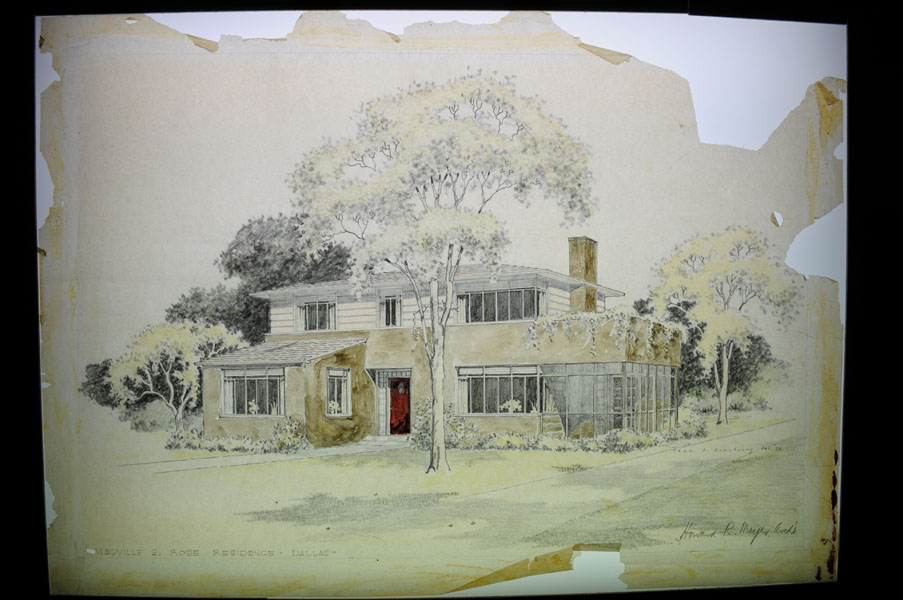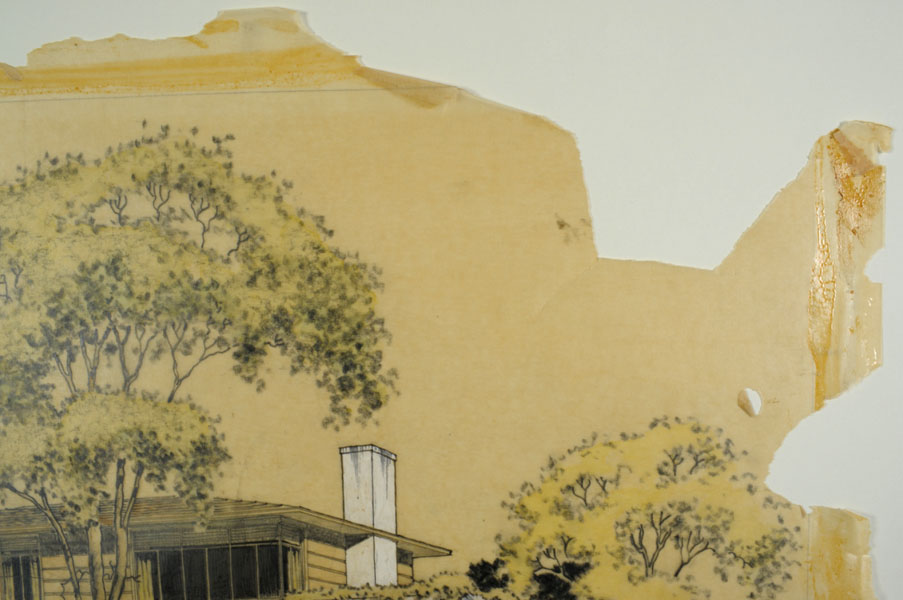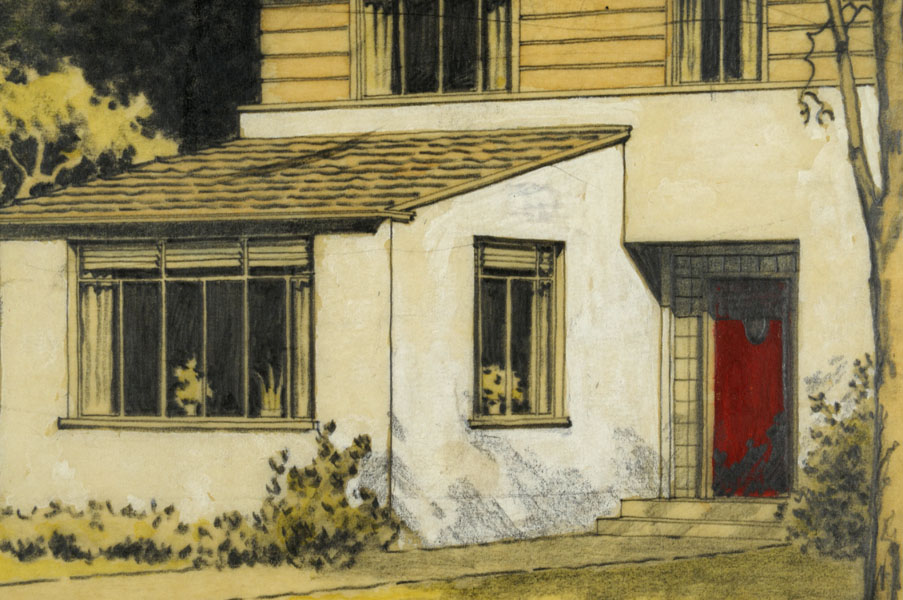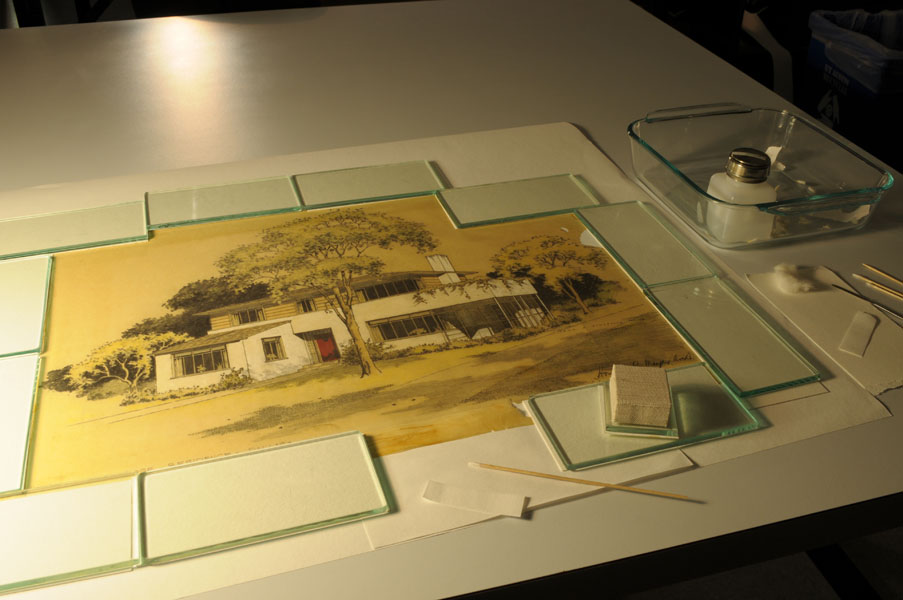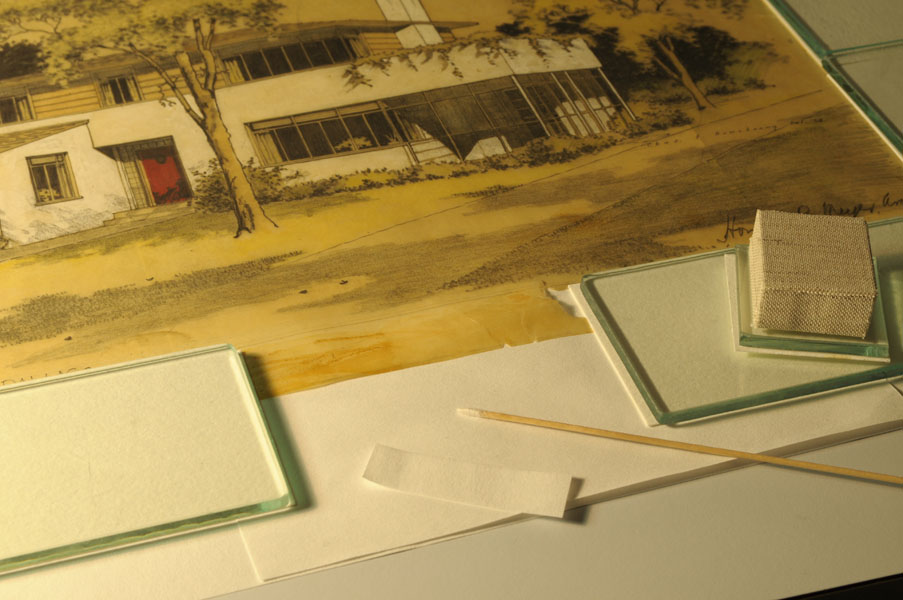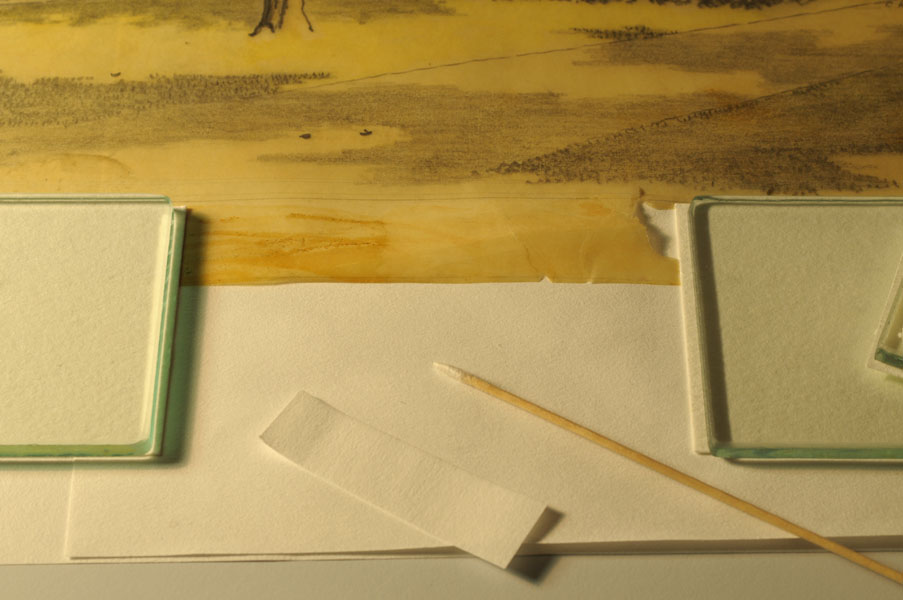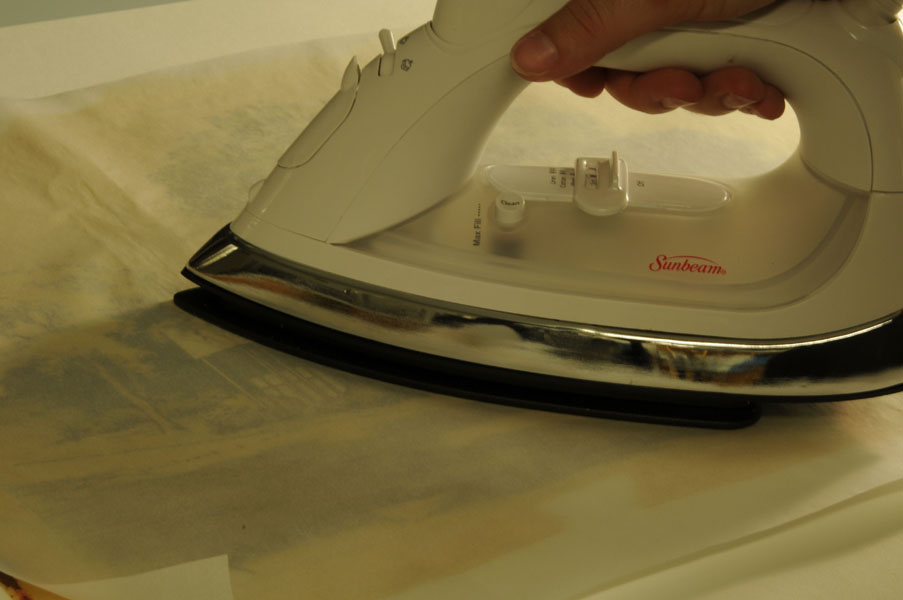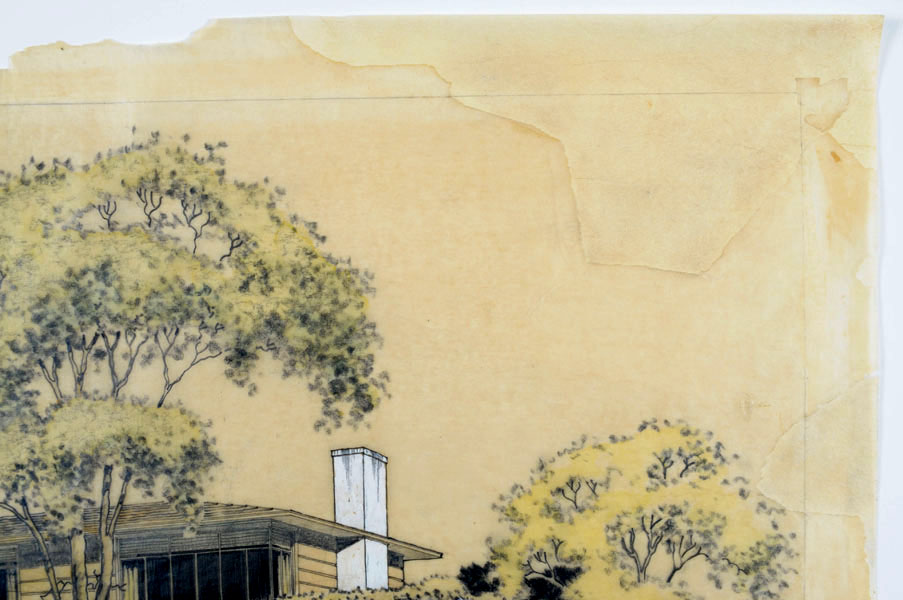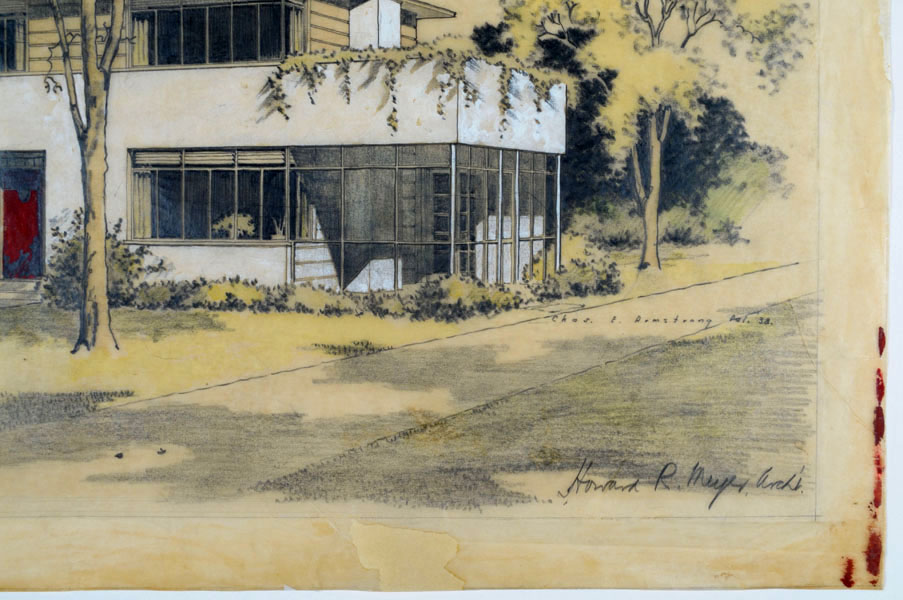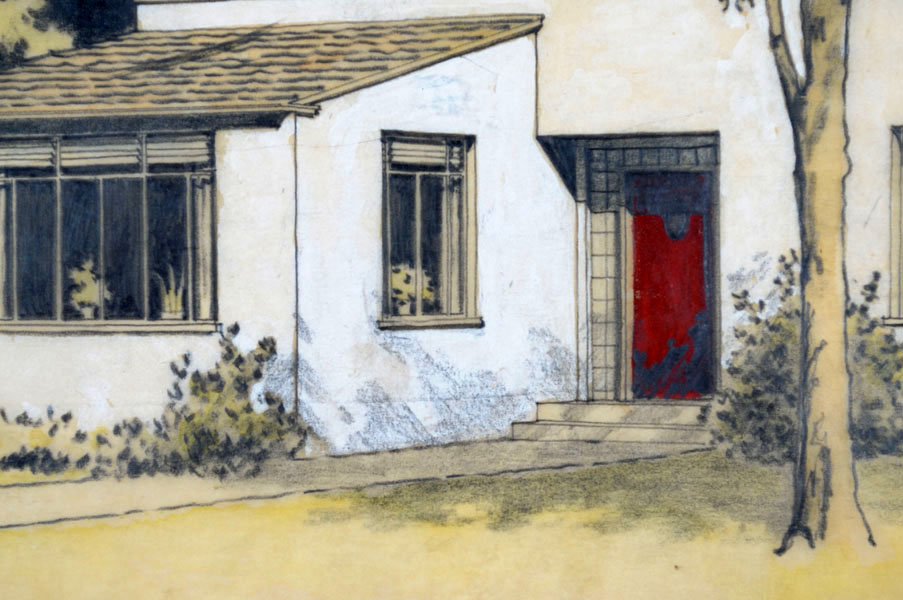Paper Treatments
Rose Residence, Howard R. Meyer Architectural Drawing
Adhesive removal, media consolidation, lining, and filling
Photo Documention
- Before
- During
- After
Click thumbnails to view images.
Treatment Report
Date: September 25, 2008
Temporary Identification number: #08-129
Owner/Custodian: Nancy Sparrow
Address: Alexander Architectural Archive, University of Texas at Austin
Telephone: 512-495-4621
Owner/Custodian call no.: MEY-19
Title/Subject/Description (.01): Melville S. Rose Residence
Creator: Chas. E. Armstrong for Howard R. Meyer, Architect
Date of production: 1938
Place of production: Dallas, TX
Approximate dimensions (hxw): 15¾ x 22 in., 40 x 55.5 cm
Conservator: Beth Antoine
Treatment Objective
The goal of this treatment is to stabilize the drawing to enable safe handling for use by researchers.
Historical Significance
The architectural presentation drawing was drafted for Howard R. Meyer, a prolific 20th century Dallas architect, known for his Modernist residential designs. As many of his houses have been and continue to be demolished to make way for new construction, his drawings are often the only record of his work.
Description & Condition
The drawing is in poor condition overall with adhesive residue and staining and several major tears and losses rendering it unsafe for handling.
General
Primary support (hxw): 15¾ x 22 in. (40 x 55.5 cm)
Image area (hxw): 13¾ x 20 in. (34.6 x 50.5 cm)
The drawing on tracing paper depicts a two story modernist residence of white stucco on the ground floor and beige siding above. The entire drawing is outlined in graphite, and many of the design elements are shaded in various gouaches and watercolors as well as graphite. The stucco exterior is shaded with a thin wash of white gouache with heavier application in the highlights. The red front door is drawn with a thick application of red gouache with an overlay of graphite in the shadows. There is a large tree in the front yard near the center of the drawing. The tree trunks and branches are outlined in graphite and shaded in red watercolor. Similarly, the darkest leaves are drawn in graphite, and the light and middle tones are washes of yellow and green watercolors. A sidewalk anchors the center of the foreground and extends to the right edge of the image. The house is nestled between the sidewalk and the heavily wooded yard in the background. The sky is defined by an absence of media.
Primary Support
The primary support is a very thin and smooth, cream colored, machine made tracing paper. The pulp distribution is quite even, giving the paper a clean, crisp appearance. There are two accretions of dirt, at the bottom center and at the upper right. A brownish-orange adhesive residue is present on approximately one inch of all margins, as well as a small area on the lower right within the image area. Likely a rubber based adhesive that has darkened with age, it was used to mount the image in a display mat. Light damage in the form of darkened paper in the image area only is further evidence that the drawing was previously matted. Although the paper remains quite flat overall, there are several tight folds and creases along all four edges. There are a number of major tears and losses, some extending into the image area. The most severe loss is on the upper right corner. In raking light droplets of a fixative are visible on the recto in the image area. The verso of the sheet shows brush strokes where an adhesive or coating may have been applied.
Media
Graphite
Likely a soft graphite, it appears shiny and dark gray to nearly black. It is lightly applied in some areas and very heavily in many others, leaving noticeable impressions in the paper. Not simply an outline or under-drawing medium, the graphite was also applied on top of other media as a shading tool. It is in good condition overall with some smudging above the main roof but below the tree branches and in the lower roof.
White Gouache
The white gouache varies in appearance from translucent to opaque depending on the application. In the most heavily applied areas, signs of cracking and flaking are visible under magnification and transmitted light.
Red Gouache
The red gouache is present on the door only, and is thickly and evenly applied. In transmitted light and magnification, severe cupping and flaking are evident.
Yellow Watercolor
The pale, cool yellow watercolor is very thinly applied and appears quite translucent. Though it may have faded while on display, it appears stable with no evidence of cracking or flaking.
Green Watercolor
The green watercolor is a cool, light color applied in thin washes and appears nearly blue in some areas. The pigment seems stable and in good condition with no evidence of friability or flaking.
Red Watercolor
The light brick red watercolor is applied so thinly that it is only noticed upon close inspection. It is possible that it was more prominent at the time of production, before the paper yellowed and darkened with age and light damage. The red wash shades the rooftops, the second floor siding, and the tree trunks. The pigment appears stable with no signs of cracking or flaking.
Treatment Proposal
- Surface clean as needed.
- Flatten creases locally as possible.
- Remove adhesive and reduce staining as possible.
- Consolidate media as possible.
- Line overall on the verso with heat-set tissue.
- Fill losses with toned tissue.
- House in acid-free folder.
Photography
Digital images were taken of the recto, verso, and details in spectral, raking and transmitted light.
Possible Effects of Treatment
Effective stain reduction may not be possible. Media may not respond to consolidation treatment.
Treatment Notes
See attached.
Treatment Performed
- Took sample of white residue from verso and mounted on a slide for microscopic analysis. (1 hr)
- Removed adhesive and reduced staining around the perimeter of the drawing on the recto with cotton swabs dampened with ethanol. Treated areas were weighted locally with Hollytex, blotter, and light weight until dry. (11 hrs)
- Reduced accretions in the image area with cotton swabs dampened with ethanol. (1.5 hrs)
- Consolidated areas of friable gouache media with a 2% gelatin solution and a leading solution of ethanol on soft brushes. (2 hrs)
- Chose lining and filling papers, made test sheet of heat-set tissue, and tested the adhesion of the lining to the drawing and to the fill paper. Papers selected follow: lining tissue - W-1 Tengucho MM, Hiromi, 2004; Fill paper - HMN-03, Hiromi, 2006. Lining prepared with Lascaux 498 HV diluted to the consistency of whole milk with de-ionized water by brushing the solution through Hollytex on silicone release Mylar and left flat to dry. (1 hr)
- Made heat-set lining as described above. (15 min)
- Toned fill tissue with Liquitex Acrylic paints diluted with de-ionized water. Pigments used: Yellow Ochre, Raw Sienna, and Cerulean Blue. (1 hr)
- Lined overall with heat-set tissue with tacking iron weighting locally as progressed. Note: The lining caused severe distortion and was immediately removed. The drawing was removed to felts with light weight. (2.5 hrs)
- Ironed with warm tacking iron to reduce distortion and transferred to felts with light weight to rest. Repeated procedure several times over three weeks until distortion reduced significantly. (5.5 hrs)
- Ironed through release paper with a large iron and transferred to blotters and boards, which were previously heated with heating pads. The blotter stack was covered with a heavy weight and kept warm with heating pads for 20 minutes. The blotter stack was then transferred to a French standing press and left to cool overnight. (1.5 hrs)
- Mended tears with Tengucho tissue and Lamatec film wrmed with a tacking iron and left to cool with light weight. (5 hrs)
- Filled losses with toned HMN-03 Gampi tissue, lined with Tengucho and Lamatec film using a warm tacking iron and light weight. (5 hrs)
- Cut window overmat and attached to back board with moistened gummed linen tape. (1 hr)
- Ironed drawing overall with large iron and left to cool between blotters and boards with heavy weight. (30 min)
- Inpainted margin lines and overall tone of fills with a 4B graphite pencil, a 6B graphite stick, powdered vine charcoal, powdered Yellow Ochre and Raw Sienna soft pastels, and a Brown Ochre pastel pencil. The powdered pigments were applied and worked with soft brushes, a soot sponge, and vinyl erasers. (1.5 hrs)
- Prepared Hugh Phibbs, non-adhesive gutter enclosure and adhered to mat with gummed linen tape. (1.5 hrs)
Total treatment time: 41.75 hours
Materials Used
Cotton Balls
Ethanol, 200 Proof, absolute anhydrous, ACS/USP grade, Pharmco-AAPER
Chromatography paper
W-1 Tengucho MM, Hiromi, 2004
HMN-03, Hiromi, 2006
Lascaux 498 HV, Conservation Resources International
Lamatec
Gelatin, purified grade, 2% warmed in de-ionized water, Fisher
Acrylic paint, Liquitex: Yellow Ochre, Raw Siena, Cerulean Blue
4-Ply Mat board
Gummed linen tape, University Products
Handmade Mulberry paper (1506), HDES International, Korea
Graphite pencil, 4B, General Pencil Co.
Graphite stick, 6B, General Pencil Co.
Artists' Vine Charcoal, extra soft, Windsor & Newton
Soft Pastels, Yellow Ochre, Raw Sienna, Rembrandt
Pastel Pencil, Brown Ochre, 57D, Derwent
Soot sponge
Vinyl Eraser
Silicone release paper
Silicone release Mylar
Hollytex
Blotter




